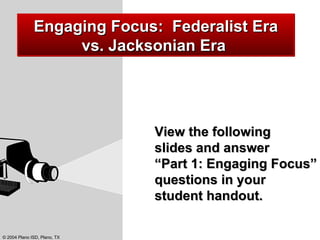
Old Hickory- Andrew Jackson
- 1. View the following slides and answer “Part 1: Engaging Focus” questions in your student handout. Engaging Focus: Federalist Era vs. Jacksonian Era
- 2. Washington and his Cabinet
- 3. Political Discussion in the 1830s
- 5. Outside the White House after Jackson’s Inauguration
- 6. The Age of Jackson
- 7. Issues that Challenged “Old Hickory”
- 8. The Election of 1824 The “Corrupt Bargain”
- 10. The vote went to the House of Representatives who picked from the top three- Jackson, Adams, and Crawford. Clay used his position as Speaker of the House to persuade representatives to vote for Adams, who won. Who will you vote for? Adams!
- 11. Adams appointed Clay Secretary of State. Jackson called the election a “Corrupt Bargain.” Why did he feel this was a “Corrupt Bargain”? Secretary of State Henry Clay
- 12. To the victor belongs the spoils! John Quincy Adams and Andrew Jackson faced each other again in the 1828 election. Jackson won by a landslide.
- 13. Spoils - benefits gained by the winner The Spoils System
- 14. After taking office, Jackson fires many Federalist officials. He gave their jobs to his loyal supporters. The Spoils System is giving political jobs to loyal supporters. OUT!!!
- 15. What is a positive aspect of the spoils system? What is a negative aspect of the spoils system?
- 17. The Kitchen Cabinet was Jackson’s unofficial advisors consisting of the press, democratic leaders, loyal supporters and friends. They met informally in the White House kitchen to discuss politics and give Jackson advice.
- 18. They were known as a “rough” group.
- 19. What is a positive aspect of the Kitchen Cabinet? What is a negative aspect of the Kitchen Cabinet?
- 20. The Bank of the United States
- 21. The Bank of the U.S. was created by Federalist Alexander Hamilton . The Bank’s purpose was to regulate economic policies.
- 22. Jackson thought the Bank was too powerful. He thought Bank president Nicholas Biddle and Bank administrators used the Bank for their own profit.
- 23. Jackson vowed, “I will kill it!” He vetoed the Bank when its charter was up for renewal. The Bank cut back on loans which hurt farmers in the West.
- 24. The Nullification Crisis Tariff Bill of 1828
- 25. Congress passed the Tariff Bill of 1828 which was the highest import tax ever. This was a “protective tariff” because it was designed to protect U.S. industry by increasing tariffs on goods from Europe.
- 26. This tax hurt Southern planters because they depended on trade with Europe. The high tariff meant Southerners still sold their cotton to Europe, but paid more for European imports.
- 27. Vice President John C. Calhoun was from South Carolina and, like most Southerners, believed in the idea of “states’ rights”. They called it the “Tariff of Abominations”. An abomination is something hated.
- 28. States’ rights is the right of states to limit the power of the federal government. South Carolina passed the Nullification Act and declared the tariff illegal. Nullify means cancel.
- 29. South Carolina threatened to secede if the tariff was not lifted. If you were Jackson, what would you do? Secede means withdraw. What are Jackson’s options?
- 30. Henry Clay designed a compromise that lowered the tariff but gave the president more power to use force if a state threatened to secede.
- 31. The Trail of Tears
- 32. Jackson believed he did not have the power as president to interfere with Georgia’s rights and stop the removal. In a desire to attract more white settlers, Georgia began moving Native Americans west. One Way
- 33. Jackson pushed the “Indian Removal Act” through Congress which gave the president power to move Native Americans west of the Mississippi.
- 34. But the Cherokee nation refused to move and took their case to the Supreme Court. In Worcester v. Georgia , the Court ruled in favor of the Cherokees. However, President Jackson refused to enforce the Court’s ruling.
- 35. Many Native Americans, mostly Cherokee, were forced to move. Besides losing their homeland, many Native Americans died along the way.
- 36. This forced removal and journey west became know as the “Trail of Tears”. Some groups, such as the Seminoles of Florida, resisted.
- 37. Led by Chief Osceola , The Seminole Indians of Florida resisted removal by fighting the U.S. government in what became known as the Seminole Wars. However, the Seminoles were eventually removed.
- 38. How do you think Andrew Jackson handled the issues of his presidency? What do you think of this common man raised in a log cabin in Tennessee?
- 39. Creating Political Cartoons Your assignment is to create two political cartoons on two different issues in Andrew Jackson’s presidency. A political cartoon makes a point or conveys the cartoonist’s opinion.
- 40. Political cartoons use symbols and words to convey their message. Political cartoons may be entertaining, but their main purpose is to challenge the reader to think. Analyze the following political cartoons:
- 41. The cartoonist thinks Jackson rules like a ____. What words and symbols are used to convey the cartoonist’s point of view? What is on the paper he is holding? What is the cartoonist trying to point out with this symbol? The cartoonist has a positive view of Jackson. True or false? He is standing on the Constitution and Bank charter.
- 42. This cartoon is about Jackson’s use of the spoils system. What clues might tell us this?
- 43. What Jackson issue is described in this cartoon? According to the cartoonist, what events might occur if Jackson continues leading the nation? “ Despotism”- a despot is someone who rules with complete and total power.
- 44. Read the information in Part 3 of the student handout for instructions on creating a political cartoon.
Hinweis der Redaktion
- http://www.nara.gov/exhall/treasuresofcongress/site.html http://www.nara.gov/exhall/treasuresofcongress/page_9.html#